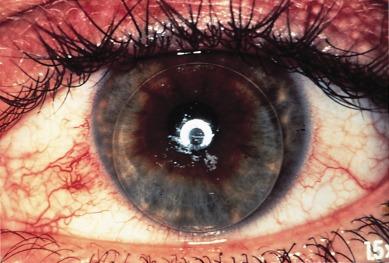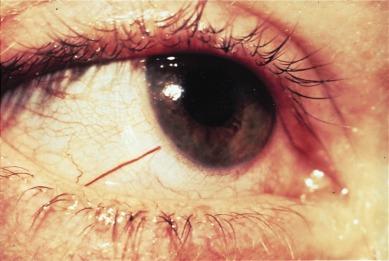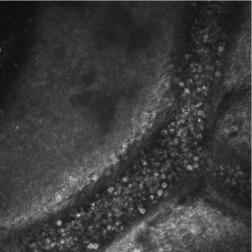Physical Address
304 North Cardinal St.
Dorchester Center, MA 02124
Increased conjunctival redness in response to contact lens wear is so easily recognised that it serves as a fundamental indicator to clinicians of the physiological status of the contact lens–wearing eye. It is not surprising that the first two clinical reports of contact lens wearing trials on humans – conducted independently in the late 1880s by Adolf Fick and August Müller – used conjunctival redness as a measure of the severity of reaction to, and time course of recovery from, lens wear.
Conjunctival redness is so obvious and easily recognizable that it is perhaps the only tissue reaction to contact lens wear that is also reported as a symptom by patients ( Fig. 13.1 ). Indeed, excessive eye redness is cosmetically unsightly and is often perceived as a disadvantage of wearing contact lenses.
It is generally recognised in eye care that the clinical presentation of a ‘red eye’ can be one of the most difficult cases to solve because of the numerous possible causes that are known. This problem may be even more complex in a contact lens wearer because there are also many other contact lens–related causes of red eye.
Throughout the literature, the terms ‘hyperaemia’, ‘injection’, ‘erythema’, ‘vascularity’ and ‘redness’ are used as synonyms. These terms are defined as follows:
Hyperaemia – increased blood in a part, resulting in distension of the blood vessels
Erythema – a redness of the skin occurring in patches of variable size or shape
Injection – a state of hyperaemia
Vascularity – the quality of vessels
Redness – of or approaching the colour seen at the least-refracted end of the spectrum, of shades varying from crimson to bright brown and orange
Strictly speaking, ‘hyperaemia’ or ‘injection’ is the cause, and ‘redness’ is the effect. That is, an increased volume of blood in the conjunctival vessels (hyperaemia or injection) causes an increased appearance of redness. The term ‘erythema’ refers to redness of skin; thus, the use of this term to describe conjunctival redness is acceptable in the broad context of considering the conjunctiva to be a specially adapted form of skin (technically it is a mucus membrane). The term ‘vascularity’ is somewhat ambiguous and could represent both the cause and the effect. Since this book is primarily structured in terms of considering clinical signs, the expression ‘conjunctival redness’ will be used here.
Most contact lens wearers will have experienced an episode of eye redness, no matter how mild, that may or may not have been related to lens wear. Reports of the prevalence of contact lens–associated eye redness vary dramatically, from 2.4% to 77% of lens wearers. This large variance in reported prevalence of conjunctival redness results from differences in methodological and reporting protocols. Some studies record if redness was the primary presenting complaint or one of a number of problems. Some studies are conducted retrospectively, and some prospectively. In reality, virtually all patients who present to their eye care practitioner complaining of ocular discomfort with contact lenses will have associated eye redness.
The term ‘conjunctival redness’ is potentially confusing because it may not be clear whether this refers to redness of the bulbar, limbal or tarsal conjunctiva. Indeed, in his 1888 thesis on contact lenses, Müller clearly differentiated among the extent of bulbar conjunctival redness, bulbar episcleral redness and limbal redness, and he used the degree of redness in these three tissue types as the basis of his analysis of the likely pathophysiological effects of lens wear. This chapter will concentrate on bulbar conjunctival redness. Tarsal conjunctival redness is considered in Chapter 14 , and limbal redness is the topic of Chapter 15 .
As with all adverse reactions that can involve a wide expanse of tissue, there may be significant regional variations in the extent of redness with respect to a given conjunctival structure. Figure 13.2 illustrates severe bulbar conjunctival redness limited to the 3 & 9 o’clock positions, associated with circumlimbal redness, in a patient wearing rigid lenses. The limbal engorgement suggests corneal involvement, which is consistent with the fact that this patient also displayed 3 & 9 o’clock staining.

There is also considerable variation in the magnitude of a hyperaemic response among individuals, as noted by Fick in his 1888 article. He observed: ‘The degree of injection … varies greatly…’. Fick also used the conjunctival hyperaemic response to discover that the eye adapts to lens wear; he observed: ‘The degree of injection … is apt to be absent entirely in those … eyes … which have already been utilised in a long series of experiments. Apparently, therefore, a sort of toleration is established very soon.’ Interestingly, Papas suggested that subjective judgments of erythema made by human observers do not rely primarily on colour but can be closely approximated by a univariate, linear model involving only the proportion of the scene occupied by vessels (i.e. erythema can be judged equally well from black-and-white images vs. colour images).
Conjunctival redness is generally asymptomatic, but patients may complain of itchiness, congestion, non-specific mild irritation or a warm or cold feeling. The existence of pain usually indicates corneal involvement (e.g. keratitis) or other tissue pathology (e.g. uveitis or scleritis).
Inferior bulbar conjunctival redness was assessed in asymptomatic contact lens wearers by McMonnies and Chapman-Davies. The mean grading of redness was as follows: No lenses, 0.8; rigid lenses, 1.0; hydrogel lenses used in the absence of preservative-based care systems, 1.5; and hydrogel lenses used in conjunction with preservative-based care systems, 2.1. Murphy et al. reported a higher grade of bulbar conjunctival redness in normal eyes of 1.9 on the BHVI grading scales. They suggested that this difference could be attributed, in part, to the different grading scales used.
Silicone hydrogel lenses seem to induce much lower levels of conjunctival redness. Numerous authors have reported that silicone hydrogel lenses worn on an extended-wear basis induced significantly lower grades of conjunctival redness compared with that observed with hydrogel extended-wear lenses. Morgan and Efron also demonstrated that silicone hydrogel lenses worn on an extended-wear basis induce relatively low grades of conjunctival redness (0.4–0.6). Covey et al. were unable to detect any difference in the grades of conjunctival redness between patients wearing silicone hydrogel lenses on an extended-wear basis (2.4 ± 0.4) and that in patients who did not wear lenses (2.3 ± 0.4).
As well as being statistically significant, these differences are undoubtedly clinically meaningful. Greater redness with hydrogel lenses, compared with no lens wear or rigid lens wear, is plausible because hydrogel lenses impinge on the limbus and conjunctiva, whereas rigid lenses generally do not. It should be noted that the study of McMonnies and Chapman-Davies was conducted in the mid-1980s – at a time when relatively unsophisticated and potentially toxic preservatives (thimerosal and chlorhexidine) were included in contact lens solutions. The use of current generation preservatives is less likely to be associated with increased conjunctival redness.
The increasing availability of video-capture technology, which can be interfaced with sophisticated computer-based image analysis systems, has led a number of researchers to develop objective techniques for measuring the level of conjunctival redness in response to contact lens wear. Owen et al. used such a system to demonstrate that over a 4-month period, rigid lens wear was associated with an increase in conjunctival redness, whereas soft lens wear was not associated with increased redness. These results do not necessarily conflict with those of McMonnies and Chapman-Davies, who examined the conjunctivae of adapted lens wearers. The data of Owen et al. probably reflect the general ocular irritation experienced during the initial adaptive phase of rigid lens wear.
Holden et al. measured the extent of general conjunctival redness and limbal redness in a group of patients who had worn a high-water-content hydrogel lens on an extended-wear basis for an average of 5 years. General conjunctival redness was graded as 0.9 (vs. 0.7 in non-lens-wearing control eyes) and limbal redness was graded as 1.1 (vs. 0.3 in non-lens-wearing control eyes). From these data, it can be inferred that extended-wear of soft lenses have a much greater effect on limbal redness compared with general conjunctival redness.
Guillon and Shah used a computer-based video-capture system to objectively monitor diurnal changes in conjunctival redness in patients wearing soft lenses on a daily-wear basis and on an extended-wear basis. Non–lens wearers displayed similar levels of redness in the morning and evening, but less redness during the day. With daily-wear lenses, conjunctival redness was greatest in the evening, whereas extended wear of soft lenses was associated with the greatest levels of redness upon waking.
Sorbara et al. compared measures of bulbar redness obtained objectively by using a photometric method with standard grading methods. They concluded that the photometric method has great potential to replace subjective grading scales, especially with multi-centre studies, where variability between investigators occurs. They also reported that the photometric method may also detect smaller changes between visits or between eyes.
Functional slit lamp biomicroscopy allows for assessment of the conjunctival microvascular responses to contact lens wear. This approach can be used to generate non-invasive bulbar conjunctival microvascular perfusion maps and to assess bulbar conjunctival morphometry and haemodynamics. A digital camera is attached to a traditional slit lamp biomicroscope to image the bulbar conjunctiva. Perfusion maps are generated and are used to measure venular blood flow haemodynamics. By using this technique, Jiang et al. found that bulbar conjunctival vessel diameter increased from 18.8 ± 2.7 μm at baseline to 19.6 ± 2.4 μm after 6 hours of soft contact lens wear (p = 0.020). The blood flow velocity was increased from 0.60 ± 0.12 mm/s to 0.88 ± 0.21 mm/s (p = 0.001). Significant increases in fractal dimensions were found after 6 hours of lens wear (p < 0.05).
The bulbar conjunctiva contains a rich plexus of arterioles. Unlike arteries, arteriolar walls contain little elastic connective tissue. They do, however, contain a thick layer of smooth muscle that is richly enervated with sympathetic nerve fibres. The smooth muscle, as well as being under central autonomic control, can be influenced by numerous local changes.
Vasodilation refers to enlargement in the circumference of a vessel resulting from relaxation of its smooth muscle layer, which leads to decreased resistance and increased blood flow through the vessel. This is known as active hyperaemia . Since blood vessels can be observed directly through the transparent conjunctiva, this leads to an appearance of increased redness (less white sclera is visible).
Vasodilation can also occur as a result of passive mechanisms, such as vessel blockages. Fig. 13.3 shows a distended arteriole, possibly caused by a blockage near the limbus.

Arteriolar muscle normally displays a state of constriction known as vascular tone . This ongoing tonic activity is attributed to two factors: (a) intrinsic myogenic activity resulting from fluctuating membrane potentials and (b) norepinephrine release from sympathetic fibres enervating the arterioles. Vessel circumference can thus be either increased or decreased by altering one or both of the above mechanisms. This can be achieved by local control mechanisms or intrinsic controls; the latter mechanism relates more to blood pressure regulation and has relatively little influence on conjunctival redness.
Insights into the inflammatory status of the conjunctiva can be examined by observing leucocytes within conjunctival vessels ( Fig. 13.4 ). Leucocyte rolling and sticking (hallmarks of the inflammatory process) was recorded using confocal microscopy by Nguyen et al. from conjunctival vessels in 55 contact lens wearers and 22 non-lens-wearing control subjects. The authors noted the presence of more rolling cells in the conjunctival vessels of those wearing low-Dk/t contact lenses than in those wearing higher-Dk/t lenses or controls. The authors suggested that their data validate a novel approach for the identification of a critical, sub-clinical component of inflammation.

Eye redness, to a varying degree, is a sign and symptom of virtually every adverse response to contact lens wear. As a physical entity that comes into direct contact with the conjunctiva, a contact lens can have a local mechanical effect on the conjunctiva, resulting in increased redness. As a device that (a) can interfere with normal metabolic processes of the cornea and conjunctiva and (b) is used in association with various solutions, a contact lens can also affect the level of conjunctival redness via a local chemical or toxic effect. Local infection and inflammation can also cause eye redness. Each of these influences shall be considered in turn.
Conjunctival arterioles are exposed to the various chemical components of the interstitial fluid in the tissue. During metabolic activity, the concentration of these chemical components can change, leading to vessel dilation and an increase in blood flow. The following metabolic influences relax arteriolar smooth muscle:
hypoxia – caused by the lens; lenses of lower oxygen transmissibility (Dk/t) induce greater levels of hypoxia;
hypercapnia – caused by the lens; lenses of lower carbon dioxide transmissibility (Dk/t) induce greater levels of hypercapnia;
acidic shift – caused by accumulation of lactic and carbonic acid as a consequence of hypoxia and hypercapnia, respectively;
increased osmolarity – caused by an increased metabolic production of osmotically active particles;
increased potassium – caused by repeated action potentials that cause a flood of potassium that cannot be removed by the sodium–potassium pump.
Non-toxic chemicals introduced into the eye either directly or indirectly (with contact lens insertion) can lead to conjunctival redness for the following reasons:
acidic shift – caused by the introduction into the eye of a solution of different pH to that of conjunctival tissue;
increased osmolarity – caused by the introduction into the eye of a hypertonic contact lens solution.
Become a Clinical Tree membership for Full access and enjoy Unlimited articles
If you are a member. Log in here